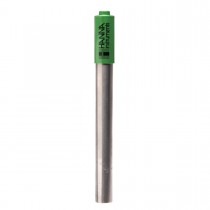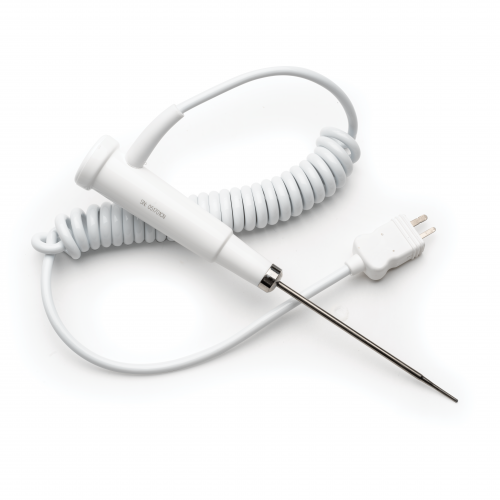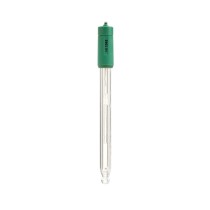The HI72911B is a titanium body, polymer filled, double reference junction pH electrode with a BNC + phono connector. This flat tip sensing portion of this electrode is made with general purpose glass.
The HI72911B has a PTFE type junction along with a built-in temperature sensor. This design consideration is ideal for measuring the pH in boilers and cooling towers. The HI72911B is designed for use with Hanna’s HI98191 pH meter.
Unbreakable Titanium Body
Built-In Temperature Sensor for Automatic Temperature Compensation
Large Annular PTFE Junction with Increased Surface Area for the Reference Cell
Details
Hanna Instruments offers a wide variety of pH electrodes that are designed for many different applications. The type of glass used, body material, type of junction, type of reference and electrolyte used are just some of the design considerations.
The HI72911B uses general purpose (GP) glass, flat tip bulb, titanium body, and PTFE junction with polymer electrolyte.
General Purpose Glass Formulation

The measurement of pH at very high temperatures is detrimental to the sensitive glass bulb and will shorten the life of it. A pH electrode with general purpose (GP) glass will have a resistance of 100 megaohms at 25°C while the resistance of LT glass is around 50 megaohms at 25°C. As the temperature of the glass decreases in the sample, the resistance of the LT glass will approach that of GP glass. If using GP glass, the resistance would increase above the optimum range, resulting in increased impedance and ultimately affecting the measurement. The HI72911B is suitable to use with samples that measure from 0 to 80°C.
Flat Tip Bulb

The recessed flat tip bulb of the HI72911B is easy to clean and prevents solids in solution from collecting on the sensor. Other tip shapes include conic for penetration and spheric for aqueous measurements.
Titanium Body

A titanium body increases immunity to electrostatic and magnetic fields. It also allows for strong corrosion resistance, even in seawater.
PTFE Junction

Porous polytetrafluoroethylene (PTFE) is a hydrophobic material that is available with different porosities. This type of junction is often used on electrodes with polymer electrolytes. Because of its chemical advantages, PTFE is widely used in industrial applications.
BNC + RCA Connector

The HI72911B uses a BNC + RCA connector. This type of connector is universal in that it can be used on Hanna pH meters that have a female BNC connector for pH and RCA input for temperature. Other type of connectors include DIN, screw type, T-type, and 3.5mm to name a few. These types of connectors tend to be proprietary for a particular type of meter and are not interchangeable.
Single Junction Versus Double Junction pH Electrodes

Conventional electrodes are normally single junction. As depicted by the figure above, these electrodes have only a single junction between the internal reference wire and the external solution. Under adverse conditions, such as high pressure, high temperature, highly acidic or alkaline solutions, the positive flow of the electrolyte through the junction is often reversed resulting in the ingress of sample solution into the reference compartment. If this is left unchecked, the reference electrode can become contaminated, leading to complete electrode failure. Another potential problem with single junction electrodes is the clogging of the junction due to silver chloride (AgCl) precipitation. Silver can be easily precipitate in samples that contain Tris buffer or heavy metals. When the electrolyte solution makes contact with the sample, some AgCl will precipitate on the external face of the junction. The result is drifty readings obtained from the sensor.
Hanna’s double junction system, as the name implies, has two junctions, only one of which is in contact with the sample as shown in the figure. Under adverse conditions, the same tendency of sample ingress is evident. However, as the reference electrode system is separated physically from the intermediate electrolyte area, the contamination of the electrode is minimized. The likelihood of clogging of the junction is also reduced with a double junction electrode since the outer reference cell uses a fill solution that is “silver-free”. Since there is no silver present, there is no precipitate that can form to clog the junction.
| Measurement Range | pH: 0 to 13 |
|---|---|
| Reference Cell Type | double, Ag/AgCl |
| Junction Type/Flow Rate | PTFE |
| Type of Electrolyte | polymer |
| Body Material | titanium |
| Tip / Shape | flat |
| Matching Pin | no |
| Max. Pressure | 3.0 bar |
| Temperature Operating Range | 0 to 80°C (32 to 176°F) – GP |
| Body Length/Overall Length | 110 mm / 150.5 mm |
| Temperature Sensor | yes |
| Outer Diameter | 14 mm |
| Cable | coaxial; 1 m (3.3’) |
| Connector Type | BNC + phono |
| Amplifier | no |
| Recommended Use | boilers, cooling towers |

![[:lt]Sidabro nitratas 0.05M, 1L - HI70429[:en]Silver Nitrate 0.05M, 1L - HI70429[:]](https://hannainst.lt/wp-content/uploads/2018/11/hi70429-1200by1200-rgb.jpg)
![[:lt]ORP elektrodas su užsikimšimo prevencijos sistema (CPS™) ir BNC jungtimi - HI3148B[:en]ORP Electrode with Clogging Prevention System (CPS™) and BNC Connector - HI3148B[:]](https://hannainst.lt/wp-content/uploads/2018/11/hi3148b.jpg)




